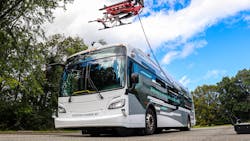Achieving Low-Carbon Benefits from Bus Yard Automation
When transit leaders consider capital investments to reduce costs, improve staff safety and prepare for a low-carbon future, automating a bus yard is an option that should receive significant consideration.
Deploying automated vehicles (AVs) in city streets is attempting to plan (“code”) for the unplannable. Movements in the yard are calculated, routine and in a confined area, making the use case for automation much more attainable in the near-term and less risky. Automating the bus yard can provide a wide variety of economic, operational and safety benefits from day one while enabling transit agencies to develop experience with automation capabilities and methodically expand their use cases.
The Federal Transit Administration (FTA) has identified several “movements” an automated bus yard (ABY) can streamline including:
- Parking and recall. Programming where and when the bus can navigate to within the bus yard creates an “automated valet service” where operators no longer have to walk long distances and risk pullout of the wrong bus. Instead, their assigned bus pulls up to the door and is ready to depart which saves valuable time and space. In a GIS study conducted on a facility at University of Michigan, the FTA estimates transit agencies can more than double the number of buses by parking closer together and in new, previously unused positions. WSP facility design subject matter experts think this number is closer to 25-35 percent capacity savings but are eager to validate in the field.
- The bus wash. This is a frequent, monotonous task that should not require an individual to be in the vehicle as it moves through the wash.
- Service bays. Depending on the fleet size, where buses park versus where they are maintained can be in different areas on the property. If a bus is scheduled for preventative maintenance or corrective maintenance, that requirement can be pre-programmed for when the operator pulls into the depot. The bus can then autonomously drive to the designated service bay.
- Fueling/Charging. Depending on the bus yard movements, once buses enter a designated area in the bus depot and with limited initiation by an operator, the buses can autonomously travel to a designated lane and either await service, park underneath an overhead charging dispenser or begin exiting for the next assigned run.
By making more efficient use of space through tighter parking and queuing, an automated yard can support bus fleets on a land footprint that is smaller than that required for a conventional bus yard. For a bus yard that serves all electric buses, WSP’s transit facility design experts estimate that the number of overhead charging dispensers required may be reduced by one-third over what would be required in a non-automated bus yard.
Rapidly Evolving Transit
Automating the bus yard may seem futuristic and speculative for transit agencies struggling daily to meet service demands while recovering from the COVID-19 pandemic and dealing with daunting workforce challenges.
As trends shaping the future of bus transit are monitored, many transit agencies—especially those with mature or emerging bus rapid transit (BRT) systems—would be well advised to begin learning about the several advantages of automating the bus yard.
Implementing an ABY involves retrofitting existing buses or procuring new buses equipped with automation kits that include sensors and onboard computers connecting to the actuators of the vehicle. The ABY can be developed with diesel or compressed natural gas (CNG) vehicles, but the most impactful synergies and benefits will be attained with a battery electric bus (BEB) fleet. This is due to the potential to automate charging operations via overhead pantograph dispensers which does not require personnel to manually plug-in chargers.
Electrification of transport, including transit buses, is proceeding rapidly on a global level. BloombergNEF estimated in its 2021 Electric Vehicle Outlook that electric buses represent 39 percent of new sales and 16 percent of the global bus fleet. Most of those electric buses—or 98 percent—are deployed in China, according to BloombergNEF.
In the U.S., transit agencies are taking widely varying approaches to converting their diesel and CNG buses to battery electric or other zero-emission technology such as hydrogen fuel cells. New York Metropolitan Transit Authority has committed to purchasing 500 new electric buses in its 2022-2024 capital budget and building charging infrastructure at eight of its 28 depots. Los Angeles County Metropolitan Transportation Authority replaced all the 60-foot articulated CNG buses on its San Fernando Valley G line with 40 New Flyer Excelsior Charge NG all-electric buses. Chicago Transit Authority committed to electrifying all of its 1,900 buses by 2040.
A Vital Strategy
Many agencies are deploying smaller-scale fleets of BEBs in demonstration projects or investing instead in small-capacity electric shuttles or rideshare vehicles—some of which also serve as test platforms for varying levels of driving automation. Transit agencies pursuing electrification also must engage other stakeholders in making major investments—especially the local electric utilities who will be called upon to upgrade power capacity on the many distribution circuits where agencies hope to locate charging infrastructure.
Still, it appears to WSP and a wide range of analysts that electrification of buses is a long-term trend that will continue to grow in the U.S. and worldwide. Despite their higher purchase costs, electric buses offer long-term return on investment with savings in fuel, maintenance and repairs, as well as eliminating the street-level pollution emitted by internal combustion engine buses. For local governments that have committed to greenhouse gas reduction targets, electrifying public transit is a vital strategy.
While the anticipated shift to automated buses is in a nascent stage, connected and automated vehicle (CAV) initiatives led by transit agencies are becoming more common. Most readers will be aware of this trend from coverage in these pages of programs such as Arlington Texas’s Arlington RAPID autonomous shared mobility platform.
At this point, however, even light-duty passenger cars like those operated by Arlington RAPID are operating with Society of Automotive Engineers (SAE) Level 3 or Level 4 technology—driving in automated mode some or most of the time, but always with drivers behind the wheel ready to take over when an unexpected challenge confounds the automated driving system (ADS).
The ADS is an important distinction in transit automation kits. ADS can perform entire dynamic driving tasks at SAE Levels 3, 4, or potentially 5, while advanced driver-assistance systems (ADAS) are associated with lower levels of automation that improve safety such as lane-keeping assist and object detection.
The automated yard is a great use case for ADS equipment. The same equipment required for ADS maneuvers can be programmed for ADAS capabilities that can provide benefits in BRT environments with precision-docking, narrow lanes and platooning buses to increase route capacity while decreasing energy use.
Projects like the CTfastrak – deploying three automated BEBs in 2023, the KCATA ADAS pilot on the MAX BRT line and the first automated bus yard specification released by Niagara Frontier Transportation Authority as an option for the ground-breaking BEB procurement, prove the market is eager to realize the benefits of ADS and ADAS transit solutions.
Low-Risk Environment
The steepness of the automated bus learning curve is a primary reason that WSP is focusing on the ABY. Compared to public bus routes where unpredictable and unusual hazards can challenge the most skilled human driver—let alone a computer—a bus yard offers a low-risk environment in which to test and gain experience with autonomous driving technology. Bus yards are secured from public access and operations are organized based on schedules and routines that can be automated relatively easily.
Currently, there are no active ABY pilot projects in the U.S., but WSP and its partner RR.AI–which is actively integrating automation kits with OEMs such as New Flyer and Gillig—jointly operate an ABY demonstration program in Clarksburg, Md., that has been visited by several Mid-Atlantic transit agencies. The next opportunity for agency staff to observe ABY operations at that facility will be in summer 2022. Additionally, a European Union-funded demonstration project by Swedish vehicle manufacturer Volvo in Paris in 2018 successfully tested automated bus parking in a multi-story bus depot, the first of its kind at an active bus depot.
ABY is an advanced concept that will require an innovative partner to demonstrate its benefits sufficiently to foster wide adoption. An ABY can offer immediate benefits in terms of improving safety for workers, allowing more dense and efficient operations, and reducing common accidents like broken mirrors that arise when drivers maneuver in tight areas. But the most significant advantages will manifest through serving electric buses.
“The growth of the battery electric bus market requires new solutions to enable efficient charging,” said Bryan Brilhart, director of operations at RR.AI. “Capabilities like autonomous precision docking enable driverless smart charging and reduce incidents of damage in bus yards. This is a near-term opportunity for transit agencies to increase service reliability and increase safety within their depots.”
Ideal Candidates
WSP and RR.AI are currently in conversations with transit agencies interested in partnering to pilot this technology and are continually meeting with interested parties. A funding opportunity will likely be made available soon by the FTA under the Strategic Transit Automation Research (STAR) Plan, which has identified the importance of an ABY demo. WSP and RR.AI have developed a strategic roadmap and a conceptual plan of operations for how an agency can make a competitive case for an ABY grant submission to FTA.
One of the most frequently asked questions on the topic is regarding the size and characteristics that would make a transit agency an ideal candidate for an ABY. Capacity-constrained depots are a top criterion and that is a box that many agencies in the country can check.
Beyond that, agencies planning to retrofit an existing bus depot and/or developing a new bus depot would be good candidates and agencies with BRT in operation or at least in planning stages are also favorable because of the benefits that an automated operations can provide to a BRT system.
Battery-electric bus garages typically use a shared charging technique that, while cost-effective, requires staff to move buses in and out of charging positions. In an automated charging scenario, a bus, once fully charged, would move seamlessly to its designated parking area, while the staged bus behind would pull forward simultaneously underneath the pantograph to be charged. This increase in operational efficiency can reduce the number of overhead pantograph chargers by 30-35 percent, providing substantial capital infrastructure cost savings.
----------------
Severin Skolrud is the emerging technology lead within the National Fleet & Facilities Division at WSP USA.

Severin Skolrud | Emerging Technology Lead, WSP USA
Severin Skolrud is the emerging technology lead within the National Fleet & Facilities Division at WSP USA.



